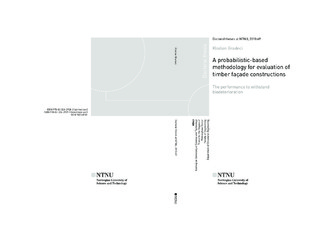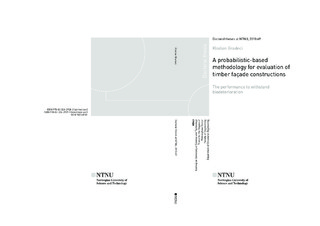| dc.contributor.advisor | Köhler, Jochen | |
| dc.contributor.advisor | Time, Berit | |
| dc.contributor.author | Gradeci, Klodian | |
| dc.date.accessioned | 2018-03-26T12:55:14Z | |
| dc.date.available | 2018-03-26T12:55:14Z | |
| dc.date.issued | 2018 | |
| dc.identifier.isbn | 978-82-326-2929-9 | |
| dc.identifier.issn | 1503-8181 | |
| dc.identifier.uri | http://hdl.handle.net/11250/2492133 | |
| dc.description.abstract | Mould and decay are biodeterioration phenomena that jeopardize the integrity, functionality and durability of timber façade constructions. Accounting for them during the design stage is crucial for the prevention of social problems and financial loss, and to ensure a healthy, safe and comfortable interior environment. The design of façade constructions is replete with uncertainties. They are mainly related to the representation of the outdoor and indoor climate, physical parameters of the materials properties and geometries, and modelling of complex physical phenomena. Current design approaches fail to account for these uncertainties, especially in representing the outdoor climate and microbial growth. The aim of this work is to develop and apply a probabilistic-based methodology, which evaluates the performance of timber façade constructions to withstand biodeterioration and accounts for the involved uncertainties. The time series analysis according to autoregressive-moving-average models is applied to develop the stochastic model representing the outdoor climate. This technique identifies mathematical expressions that can generate probable patterns of the weather data in a time series containing plausible sequences, frequencies and correlations, future trends of the climate and can be long enough to resemble the expected service life. The temperature-dependent thermal conductivity of the insulation material is investigated by carrying out lab measurements, and subsequently, a stochastic model is developed to represent this property. Deficiencies, considering penetration of wind-driven rain, are accounted for and represented by different moisture sources. Moreover, the development of criteria and models representing mould growth in wood-based materials are investigated by carrying out a systematic literature review. Subsequently, three mould models are selected to derive the mould growth outcome as a mixture of their distribution to account for their competencies and diminishing their limitations in representing mould. This outline derives the likelihoods of potential levels of mould growth; hence, facilitates their association to the corresponding consequences adapted from the case study at hand. Uncertainty and sensitivity analysis methods are performed to quantify the ranges of the output, the likelihood of each outcome and to evaluate the significance of key contributors to output uncertainty. The methodology is applied to evaluate traditional and modern façade constructions. The results prove that the probabilistic-based methodology enables a more systematic approach to the evaluation of façade constructions. It accounts for the involved uncertainties, provides a clear association of microbial growth and its likelihood, and enables the identification and significance of the dominant parameters; hence, it delivers a more comprehensive representation to evaluate construction performance. The methodology can facilitate the development of cost-optimisation and risk-based inspection planning methodologies, and enable the upgrading of current codes and standards.
Keywords: mould; decay; façade; probabilistic; uncertainty; sensitivity analysis. | nb_NO |
| dc.language.iso | eng | nb_NO |
| dc.publisher | NTNU | nb_NO |
| dc.relation.ispartofseries | Doctoral theses at NTNU;2018:69 | |
| dc.relation.haspart | Paper 1:
Gradeci, Klodian; Labonnote, Nathalie; Time, Berit; Kohler, Jochen.
A proposed probabilistic-based design methodology for predicting mould occurrence in timber façades. I: World Conference on Timber Engineering (WCTE 2016). | |
| dc.relation.haspart | Paper 2:
Gradeci, Klodian; Labonnote, Nathalie; Time, Berit; Kohler, Jochen.
Mould growth criteria and design avoidance approaches in wood-based materials - A systematic review. Construction and Building Materials 2017 ;Volum 150. s. 77-88
https://doi.org/10.1016/j.conbuildmat.2017.05.204 | |
| dc.relation.haspart | Paper 3:
Gradeci, Klodian; Labonnote, Nathalie; Kohler, Jochen; Time, Berit.
Mould models applicable to wood-based materials – a generic framework. Energy Procedia 2017 ;Volum 132. s. 177-182
https://doi.org/10.1016/j.egypro.2017.09.751
(CC BY-NC-ND 4.0) | |
| dc.relation.haspart | Paper 4 :
Gradeci, Klodian; Labonnote, Nathalie; Time, Berit; Kohler, Jochen.
A probabilistic-based methodology for predicting mould growth in façade constructions. Building and Environment 2017 ;Volum 128. s. 33-45
https://doi.org/10.1016/j.buildenv.2017.11.021 | |
| dc.relation.haspart | Paper 5:
Gradeci, Klodian; Berardi, Umberto; Time, Berit; Kohler, Jochen.
Evaluating highly insulated walls to withstand biodeterioration: A probabilistic-based methodology.
© 2018. This manuscript version is made available under the CC-BY-NC-ND 4.0 license
- Final published version in
Energy and Buildings 2018 ;Volum 177. s. 112-124
https://doi.org/10.1016/j.enbuild.2018.07.059 | |
| dc.relation.haspart | Paper 6:
Gradeci, Klodian; Baravalle, Michele; Time, Berit; Kohler, Jochen.
Cost-Optimisation for Timber Façades Exposed to Rot Decay. I: Proceedings of the 12th International Conference on Structural Safety and Reliability (ICOSSAR2017) | |
| dc.title | A probabilistic-based methodology for evaluation of timber facade constructions - The Performance to withstand biodeterioration | nb_NO |
| dc.type | Doctoral thesis | nb_NO |
| dc.subject.nsi | VDP::Teknologi: 500::Bygningsfag: 530::Konstruksjonsteknologi: 533 | nb_NO |
| dc.description.localcode | Digital full text not available | nb_NO |

